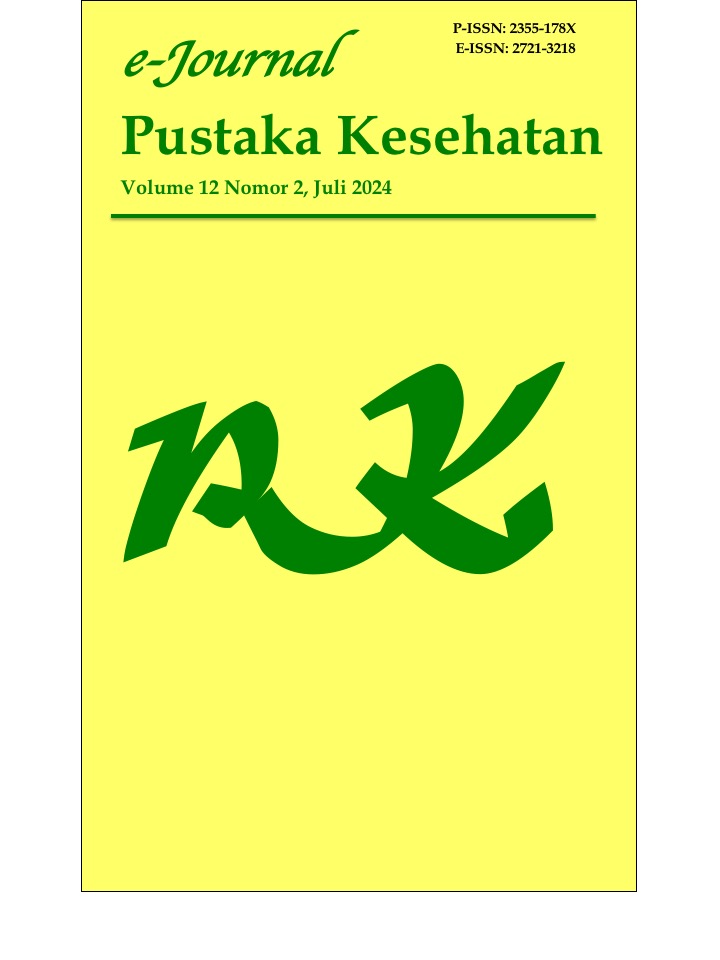Optimasi Tween 80 dan PEG 400 dalam Self Nanoemulsifying Drug Delivery System Antibakteri dari Minyak Daun Kemangi
DOI:
https://doi.org/10.19184/pk.v12i2.22583Keywords:
basil, SNEDDS, Tween 80, PEG 400, factorial designAbstract
Basil has antibacterial activity against Salmonella typhi with essential oils as active compounds. However, its volatile and hydrophobic nature makes it difficult to dissolve in the gastrointestinal tract so a self nanoemulsifying drug delivery system (SNEDDS) is needed. The study aimed to determine the effect of changes in the concentration and interaction of Tween 80 and PEG 400 on the percent transmittance response and emulsification time in SNEDDS of basil leaf oil. This research optimized of Tween 80 and PEG 400 using basil leaf oil as the oil phase with the percent transmittance response and emulsification time, then verified, characterized the organoleptic, pH, particle size, size distribution, and antibacterial activity. The concentration of Tween 80 and of PEG 400 would increase the percent transmittance and decrease the emulsification time. The interaction between two substances can decrease the percent transmittance and increase the emulsification time. The prediction software design expert 11 SNEDDS optimum formula namely Tween 80 2.05 ml and PEG 400 1.35 ml. The characteristics of the optimum formula produced were clear yellow with a distinctive basil aroma, pH 6.93±0.02, particle size 183.3±0.21 nm, and PI 0.341±0.02. SNEDDS of basil leaf oil inhibits S. typhi with an inhibition zone of 19.22 ± 0.01 mm.
Downloads
References
[2] C. Lesser and S. Miller, Harrison’s principles of internal medicine, 15th edition. New York: Mc Graw Hill Companies, 2001.
[3] M. Kristiani, S. L. Ramayani, K. Yunita, and M. Saputri, “Formulasi dan Uji Aktivitas Nanoemulsi Minyak Atsiri Daun Kemangi ( Ocimum basilicum L .) Terhadap Salmonella typhi,†JurnalFarmasi Indones., vol. 16, no. 1, pp. 14–23, 2019.
[4] A. R. Bilia, C. Guccione, B. Isacchi, C. Righeschi, F. Firenzuoli, and M. C. Bergonzi, “Essential oils loaded in nanosystems: A developing strategy for a successful therapeutic approach,†Evidence-based Complement. Altern. Med., vol. 2014, p. 14, 2014.
[5] L. Shargel, S. Wu-Pong, and A. Yu, Applied Biopharmaceutics and Pharmacokinetics Ed V. Singapore: The McGraw- Hill, 2005.
[6] A. A. Date, N. Desai, R. Dixit, and M. Nagarsenker, “Self-nanoemulsifying drug delivery systems: Formulation insights, applications and advances,†Nanomedicine, vol. 5, no. 10, pp. 1595–1616, 2010.
[7] R. C. Rowe, P. J. Sheskey, and M. E. Quinn, Handbook-of-Pharmaceutical-Excipients 6th Edition. London: Pharmaceutical Press, 2009.
[8] J. Patel, G. Kevin, A. Patel, M. Raval, and N. Sheth, “Design and development of a self-nanoemulsifying drug delivery system for telmisartan for oral drug delivery,†vol. 1, no. 2, pp. 112–118, 2011.
[9] N. Huda and I. Wahyuningsih, “Karakterisasi Self-Nanoemulsifying Drug Delivery System (SNEDDS) Minyak Buah Merah (Pandanus conoideus Lam.),†J. Farm. Dan Ilmu Kefarmasian Indones., vol. 3, no. 2, p. 49, 2018.
[10] J. Ahmad, K. Kohli, S. R. Mir, and S. Amin, “Formulation of self-nanoemulsifying drug delivery system for telmisartan with improved dissolution and oral bioavailability,†J. Dispers. Sci. Technol., vol. 32, no. 7, pp. 958–968, 2011.
[11] R. Rinaldy, “Optimasi formula emulsi kombinasi minyak zaitun dan ekstrak buah alpukat menggunakan metode factorial design,†Skripsi : Universitas Muhammadiyah Surakarta, 2018.
[12] S. K. Savale, “a Review - Self Nanoemulsifying Drug Delivery System (Snedds),†Int. J. Res. Pharm. Nano Sci., vol. 4, no. 6, pp. 385–397, 2015.
[13] S. H. Yuliani, M. Hartini, Stephanie, B. Pudyastuti, and E. P. Istyastono, “Perbandingan Stabilitas Fisis Sediaan Nanoemulsi Minyak Biji Delima Dengan Fase Minyak Long-Chain Triglyceride Dan Medium-Chain Triglyceride,†Tradit. Med. J., vol. 21, no. 2, pp. 93–98, 2016.
[14] B. H. Nugroho, S. Citrariana, I. N. Sari, R. N. Oktari, and Munawwarah, “Formulasi dan evaluasi SNEDDS ( Self Nanoemulsifying Drug Delivery System ) ekstrak daun pepaya ( Carica papaya L .) sebagai analgesik,†J. Ilm. Farm., vol. 13, no. 2, pp. 77–85, 2017.
[15] L. Wahyuningsih and W. Putranti, “Optimasi Perbandingan Tween 80 Dan Polietilenglikol 400 Pada Formula Self Nanoemulsifying Drug Delivery System (SNEDDS) Minyak Biji Jinten Hitam,†Pharmacy, vol. 12, no. 02, pp. 223–241, 2015.
[16] S. E. Priani, S. Y. Somantri, and R. Aryani, “Formulasi dan Karakterisasi SNEDDS (Self Nanoemulsifying Drug Delivery System) Mengandung Minyak Jintan Hitam dan Minyak Zaitun,†J. Sains Farm. Klin., vol. 7, no. 1, p. 31, 2020.
Downloads
Published
Issue
Section
License
e-Journal Pustaka Kesehatan has CC-BY-SA or an equivalent license as the optimal license for the publication, distribution, use, and reuse of scholarly work. Authors who publish with this journal retain copyright and grant the journal right of first publication with the work simultaneously licensed under a Creative Commons Attribution-ShareAlike 4.0 International License that allows others to share the work with an acknowledgment of the work's authorship and initial publication in this journal.



